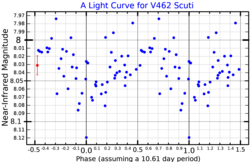 A near-infrared (2.033 micron) light curve for V462 Scuti, adapted from Chené and St-Louis (2007). The left-most point shows the 3 sigma error bar. | |
| Observation data Epoch J2000 Equinox J2000 | |
|---|---|
| Constellation | Scutum |
| Right ascension | 18 41 00.86698 |
| Declination | −4° 26′ 14.47345″ |
| Apparent magnitude (V) | 11.93 |
| Characteristics | |
| Evolutionary stage | Wolf-Rayet |
| Spectral type | WN7w + WN3/4 |
| U−B color index | 0.13 |
| B−V color index | 1.04 |
| Astrometry | |
| Proper motion (μ) | RA: −0.489 mas/yr Dec.: −2.524 mas/yr |
| Parallax (π) | 0.3246 ± 0.0541 mas |
| Distance | approx. 10,000 ly (approx. 3,100 pc) |
| Absolute magnitude (MV) | −3.81 |
| Details | |
| Mass | 7 M☉ |
| Radius | 3.78 R☉ |
| Luminosity | 83,200 L☉ |
| Temperature | 50,100 K |
| Other designations | |
| MR 89, V462 Scuti, 2MASS J18410086-0426145 | |
| Database references | |
| SIMBAD | data |
WR 120 is a binary containing two Wolf-Rayet stars in the constellation of Scutum, around 10,000 light years away. The primary is a hydrogen-free weak-lined WN7 star, the secondary is a hydrogen-free WN3 or 4 star, and the system is a possible member of the cluster Dolidze 33. From our point of view, WR 120 is reddened by 4.82 magnitudes, and it has the variable designation of V462 Scuti.
Properties
Analysis of the primary's spectrum with PoWR shows that it has a temperature of around 50,000 Kelvins, and is losing mass at a rate of 10 M☉/year, or 1 solar mass every 80,000 years, which is being carried away from the surface at a speed of 1,225 kilometres per second. Taking its close distance into account, WR 120 A's luminosity turns out to be a mere 83,200 L☉, which would make it one of the dimmest WN stars known, and one of the only WN stars with a luminosity below 100,000 L☉. Using the Stefan-Boltzmann Law, a radius of 3.78 R☉ is derived, and a "transformed" radius at an optical depth of 2/3, more comparable to other types of stars, is at about 6 R☉. Using the WR Luminosity-Mass ratio, WR 120 may have a mass of just 7 M☉, one of the lowest masses of any WR star. WR 120 A’s visual luminosity is 2,858 L☉, which is also on the lower end of WR visual luminosities.
WR 120 is thought to be a member of Dolidze 33, an open cluster nearly 3,000 pc away.
Binarity
In 2021, WR 120 was revealed to be a binary star. Previously, it was thought to be a single WR star, but it is in fact a rare double Wolf-Rayet star. The companion (a WN3/4 WR star) is located approximately 1700 AU from the primary WN7 WR, and is about 2.1 magnitudes fainter than WR 120.
References
- Chené, André-Nicolas (2007). "The First Determination of the Rotation Rates of Wolf-Rayet Stars". Massive Stars as Cosmic Engines, Proceedings IAU Symposium. 250: 139–144. doi:10.1017/S1743921308020425.
- ^ Gaia Collaboration (2018-04-01). "VizieR Online Data Catalog: Gaia DR2 (Gaia Collaboration, 2018)". VizieR Online Data Catalog. 1345. Bibcode:2018yCat.1345....0G. doi:10.26093/cds/vizier.1345.
- Zacharias, N. (2012). "The fourth US Naval Observatory CCD Astrograph Catalog (UCAC4)". VizieR On-line Data Catalog. Bibcode:2012yCat.1322....0Z.
- ^ Hamann, W.-R.; Gräfener, G.; Liermann, A.; Hainich, R.; Sander, A. A. C.; Shenar, T.; Ramachandran, V.; Todt, H.; Oskinova, L. M. (2019-05-01). "The Galactic WN stars revisited. Impact of Gaia distances on fundamental stellar parameters". Astronomy and Astrophysics. 625: A57. arXiv:1904.04687. Bibcode:2019A&A...625A..57H. doi:10.1051/0004-6361/201834850. ISSN 0004-6361. S2CID 104292503.
- Shara, Michael M.; Howell, Steve B.; Furlan, Elise; Gnilka, Crystal L.; Moffat, Anthony F. J.; Scott, Nicholas J.; Zurek, David (2022-01-01). "A speckle-imaging search for close and very faint companions to the nearest and brightest Wolf-Rayet stars". Monthly Notices of the Royal Astronomical Society. 509 (2): 2897–2907. arXiv:2109.06975. Bibcode:2022MNRAS.509.2897S. doi:10.1093/mnras/stab2666. ISSN 0035-8711.
- ^ Ducati, J. R. (2002). "VizieR Online Data Catalog: Catalogue of Stellar Photometry in Johnson's 11-color system". VizieR Online Data Catalog. 2237. Bibcode:2002yCat.2237....0D.
- ^ Brown, A. G. A.; et al. (Gaia collaboration) (2021). "Gaia Early Data Release 3: Summary of the contents and survey properties". Astronomy & Astrophysics. 649: A1. arXiv:2012.01533. Bibcode:2021A&A...649A...1G. doi:10.1051/0004-6361/202039657. S2CID 227254300. (Erratum: doi:10.1051/0004-6361/202039657e). Gaia EDR3 record for this source at VizieR.
- ^ Rate, Gemma; Crowther, Paul A.; Parker, Richard J. (2020-06-01). "Unlocking Galactic Wolf-Rayet stars with Gaia DR2 - II. Cluster and association membership". Monthly Notices of the Royal Astronomical Society. 495 (1): 1209–1226. arXiv:2005.02533. Bibcode:2020MNRAS.495.1209R. doi:10.1093/mnras/staa1290. ISSN 0035-8711.
- Crowther, Paul A.; Rate, Gemma (2020). "Unlocking Galactic Wolf–Rayet stars with Gaia DR2 – I. Distances and absolute magnitudes". Monthly Notices of the Royal Astronomical Society. 493 (1): 1512–1529. arXiv:1912.10125. Bibcode:2020MNRAS.493.1512R. doi:10.1093/mnras/stz3614. S2CID 209444955.
| Constellation of Scutum | |||||||
|---|---|---|---|---|---|---|---|
| Stars |
| ||||||
| |||||||
| Star clusters |
| ||||||
| |||||||